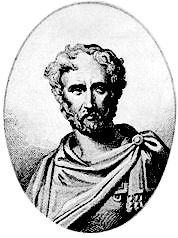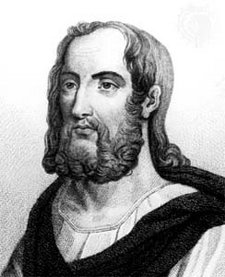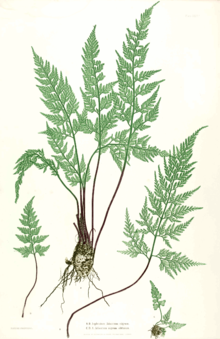MEDICINA: PLINIO EL VIEJO RECOPILO PARTE DE LA MEDICINA TRADICIONAL ANTIGUA DEL OCCIDENTE EN SU OBRA "MEDICINA PLINII". Hacia la mitad del siglo III, un resumen de las partes geográficas de la obra de Plinio fue realizado por Solino, y al inicio del siglo IV, los pasajes sobre medicina fueron reunidos en los Medicina Plinii. A comienzos del siglo VIII, Beda el Venerable poseía un manuscrito de toda la obra. En el siglo IX, Alcuino envió a Carlomagno un ejemplar de los primeros libros (Epp. 103, Jaffé); y Dicuil reunió extractos de las páginas de Plinio para su Mensura orbis terrae (c. 825). Los trabajos de Plinio fueron tenidos en gran estima en la Edad Media.

PLINIO "EL VIEJO"
Medicina Plinii
From Wikipedia, the free encyclopedia
|
The Medicina Plinii or Medical Pliny is an anonymous Latin compilation of medical remedies dating to the early 4th century A.D. The excerptor, saying that he speaks from experience, offers the work as a compact resource for travelers in dealing with hucksters who sell worthless drugs at exorbitant prices or with know-nothings only interested in profit.[1] The material is presented in three books in the conventional order a capite ad calcem (“from head to toe,” in the equivalent English expression), the first dealing with treatments pertaining to the head and throat, the second the torso and lower extremities, and the third systemic ailments, skin diseases, and poisons.
The book contains more than 1,100 pharmacological recipes, the vast majority of them from the Historia naturalis of Pliny the Elder.[2] Other sources include Celsus, Scribonius Largus, and Dioscorides.[3] Most of the recipes contain a limited number of ingredients, and in contrast to more expansive and thorough collections such as the De medicamentis liber of Marcellus Empiricus, precise measurements in drachmae, denarii or other units are specified for only a few formulations.
Perhaps because Pliny's name was attached to it, the book enjoyed great popularity and influence, with many manuscript versions from the Middle Ages.[4] It was often used as a handbook in monastic infirmaries.[5]
The collection is also referred to as Medicina Plinii Secundi or Plinii valeriani, and its authorship is sometimes noted as “Pseudo-Pliny.”[6] It was a major source for the Physica Plinii, a 5th- or 6th-century medical compilation.[7]
[edit] Sample remedies
The ingredients and methods in the Medicina Plinii are typical of Latin pharmacological handbooks. Materials may be botanical, animal-derived, or metallic; processes include decoction, emulsification, calcination and fermentation. Preparations may be applied topically, or consumed. Magic, perhaps to be compared with faith healing,[8] was a regular feature of the manuals.
Following is a prescription for bloodshot eyes:
| “ | Use the blood of a dove or pigeon or partridge or turtledove as drops. Apply a decoction of spleenwort in honey and a wool bandage soaked with oil or wine. An application of rue root also makes it better.[9] | ” |
Several treatments are listed for quartan fever (quartanis, probably malaria). The first requires a nail that was used in a crucifixion, which is to be bound to the head with a strip of cloth, or a rope from a cross, then sprinkled with calcined cow manure.[10] In the eight sentences of remedies — involving, among other substances, dill seed, hare's heart, a boy's urine, and a frog boiled in oil, not to mention the capture, ear-clipping, and release of a live mouse — the absence of syntactical transitions makes it less clear than in the work of Marcellus whether a sequence of treatment is meant or a series of alternatives offered. The chapter concludes with a charm and careful instructions to the practitioner:
| “ | You write the following on a virgin sheet of papyrus, which the patient is to wear fastened on his right wrist: 'Back off from this person Gaius Seius, Fever, Solomon pursues you.' In the same manner, bind bread and salt in linen suspended from a string[11] and tie around a tree with a string and adjure the bread and salt three times: 'My guests are to arrive tomorrow, watch out for them.' He is to say this three times.[12] | ” |
The sympathetic magic employed here (tree = person) is similar to arboreal healing charms in Cato the Elder and Marcellus.[13] The name "Gaius Seius" (or "Gaius Lucius") was the Latin equivalent of John Doe; the patient's name was to be substituted.[14] Magico-medical spells and inscriptions, as on amulets, frequently personify and apostrophize the ailment (here, "Fever").[15] The reference to Solomon is a perhaps unexpected but not unusual reminder of the syncretistic, international character of Hellenistic magic; Solomon is frequently invoked in healing charms or depicted on amulets as driving away or defeating an affliction.[16]
As Calvert Watkins has pointed out, “magical, carminative medicine was in Indo-European culture and society a manifestation of the power of the spoken word,” and was one of the three modes of healing: surgery, botanical pharmacology, and formulaic magic.[17] As recipients of this tradition, Greek and Roman medical writers offered magical, verbal therapies along with theoretical and empirical approaches. From the perspective of modern medicine, the irrational element can perhaps be overemphasized; it should be noted that many remedies in the Medicina Plinii, such as a topical cream for sores made from bear fat and red clay,[18] or any number of potent herbal preparations, are typical of traditional medicine and contain active ingredients with demonstrated effect.
[edit] Editions
- Rose, Valentino. Plinii secundi quae fertur una cum Gargili Martialis Medicina. Leipzig: Teubner, 1875.
- Önnerfors, Alf. Plinii secundi iunioris qui feruntur de medicina libri tres. Corpus Medicorum Latinorum 3. Berlin 1964.
[edit] See also
- Ancient Greek medicine
- Medicine in ancient Rome
- Medieval medicine
- Scribonius Largus
- Marcellus Empiricus
[edit] References
- ^ Frequenter mihi in peregrinationibus accidit ut aut propter meam aut propter meorum infirmitatem varias fraudes medicorum experiscerer, quibusdam vilissima remedia ingentibus pretiis vendentibus, aliis ea quae curare nesciebant cupiditatis causa suscipientibus, from Plinii secundi iunioris de medicina, prologue 1, p. 4 in the edition of Alf Önnerfors, Corpus Medicorum Latinorum 3 (Berlin 1964); William D. Sharpe, introduction to “Isidore of Seville: The Medical Writings. An English Translation with an Introduction and Commentary,” Transactions of the American Philosophical Society 54 (1964), p. 13.
- ^ D.R. Langlow, Medical Latin in the Roman Empire (Oxford University Press, 2000), p. 64.
- ^ Alf Önnerfors, preface to Plinii secundi iunioris qui feruntur de medicina libri tres, Corpus Medicorum Latinorum 3 (Berlin 1964), p. xxxi.
- ^ D.R. Langlow, Medical Latin in the Roman Empire (Oxford University Press, 2000), p. 64.
- ^ Eva Matthews Sanford, “Famous Latin Encyclopedias,” Classical Journal 44 (1949), p. 463.
- ^ William D. Sharpe, introduction to “Isidore of Seville: The Medical Writings. An English Translation with an Introduction and Commentary,” Transactions of the American Philosophical Society 54 (1964), p. 13; D.R. Langlow, Medical Latin in the Roman Empire (Oxford University Press, 2000), p. 64.
- ^ J.N. Adams and Marilyn Deegan, "Bald's Leechbook and the Physica Plinii," in Anglo-Saxon England (Cambridge University Press, 1998), p. 89.
- ^ Peter Brown, The Cult of the Saints (University of Chicago Press, 1981), pp. 113–114, comparing magic in the De medicamentis of Marcellus Empiricus to the faith healing of Martin of Tours.
- ^ Medicina Plinii 1.9, "Oculis suffusis sanguine," p. 17 in Önnerfors.
- ^ Caput clavi quo aliquis in crucem fixus est alligatur panno, vel spartum de cruce. fimi bubuli cinis spargitur (Medicina Plinii 3.15.1, p. 77 in Önnerfors). The nail is an instrument of Hellenistic magic; the term defixio in Latin, referring to a curse tablet or binding spell, means the act of nailing down or fastening. See Christopher A. Faraone, "The Agonistic Context of Early Greek Binding Spells," in Magika Hiera: Ancient Greek Magic and Religion (Oxford University Press, 1991), pp. 3–32, with additional perspective from H.S. Versnel, "Beyond Cursing: The Appeal to Justice in Judicial Prayers," pp. 60–63 in the same volume.
- ^ In linteo de licio, presumably as a sort of pouch.
- ^ Medicina Plinii 3.15.7–8, p. 78 in Önnerfors.
- ^ Walton Brooks McDaniel, "A Sempiternal Superstition," Classical Journal 45 (1950) 171–176 and 233–236, with examples from continuing folk practice; Roy Kotansky, “Incantations and Prayers for Salvation on Inscribed Greek Amulets,” in Magika Hiera: Ancient Greek Magic and Religion, edited by Christopher A. Faraone and Dirk Obbink (Oxford University Press, 1991), pp. 108–109 on binding spells.
- ^ A. Souter, review of The Work of St. Optatus, Bishop of Milevis, against the Donatists by O.R. Vassall-Phillips, in English Historical Review 32 (1917), p. 428; Oxford Latin Dictionary (Oxford: Clarendon Press 1982, 1985 printing), entry on "Gaius," p. 752.
- ^ F. C. Conybeare, "Christian Demonology," part two, Jewish Quarterly Review 9 (1896), p. 95; Roy Kotansky, “Incantations and Prayers for Salvation on Inscribed Greek Amulets,” in Magika Hiera (Oxford University Press, 1991), pp. 111–113, 118–119.
- ^ See, for instance, William M. Brashear, “The Greek Magical Papyri," Aufstieg und Niedergang der römischen Welt II, 18.5 (1995), p. 3430ff; on Solomon, A.A. Barb, "Antaura. The Mermaid and the Devil's Grandmother: A Lecture," Journal of the Warburg and Courtauld Institutes 29 (1966) 1–23, especially p. 6.
- ^ Calvert Watkins, How to Kill a Dragon: Aspects of Indo-European Poetics (Oxford University Press, 1995), pp. 537–540.
- ^ Medicina Plinii 2.23.1, p. 56 in Önnerfors.


0 comentarios